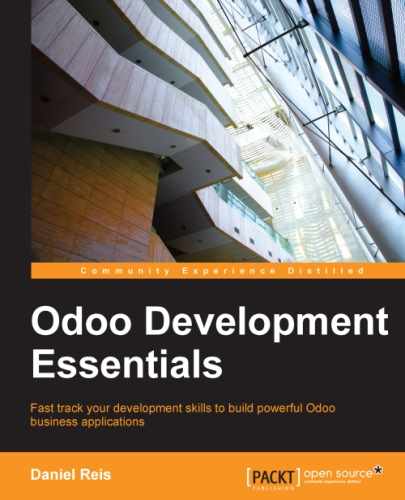Book Description
Fast track your development skills to build powerful Odoo business applications
In Detail
Odoo is a powerful and fast-growing business application platform. Beginning with setting up the development environment, this book will then guide you through a practical journey to build feature-rich business applications.
With the aim of jumpstarting your Odoo proficiency level, from no specific knowledge to application development readiness, you will be set on the path of developing your first Odoo application. Then, you will move on to topics such as models and views and understanding and using server APIs to add business logic, which will lay a solid foundation for advanced topics.
The book concludes with a guide to Odoo interaction and how to use the Odoo API from other programs, all of which will enable you to efficiently integrate applications with other external systems.
What You Will Learn
- Set up a development environment and manage your Odoo instances and databases
- Develop from a remote Workstation such as Windows using Odoo
- Create your first Odoo application and get acquainted with the development workflow
- Build module extensions and understand the inheritance mechanisms
- Use XML and CSV data files and external IDs to load and export data for your business applications
- Structure the application data model using Odoo's Object Relation Mapping (ORM) capabilities
- Design effective user interfaces using forms, lists, and kanban views
- Integrate Odoo with other systems using the external API
- Deploy Odoo and your business application for production use
Downloading the example code for this book. You can download the example code files for all Packt books you have purchased from your account at http://www.PacktPub.com. If you purchased this book elsewhere, you can visit http://www.PacktPub.com/support and register to have the files e-mailed directly to you.
Table of Contents
- Odoo Development Essentials
- Table of Contents
- Odoo Development Essentials
- Credits
- About the Author
- About the Reviewers
- www.PacktPub.com
- Preface
- 1. Getting Started with Odoo Development
- 2. Building Your First Odoo Application
- Understanding applications and modules
- Modifying and extending modules
- Creating a new module
- Adding to the addons path
- Installing the new module
- Upgrading a module
- Creating an application model
- Adding menu entries
- Creating views – form, tree, and search
- Adding list and search views
- Adding business logic
- Setting up access control security
- Row-level access rules
- Adding an icon to the module
- Summary
- 3. Inheritance – Extending Existing Applications
- 4. Data Serialization and Module Data
- 5. Models – Structuring the Application Data
- 6. Views – Designing the User Interface
- 7. ORM Application Logic – Supporting Business Processes
- 8. QWeb – Creating Kanban Views and Reports
- Getting started with kanban board
- Design kanban views
- Adding QWeb dynamic content
- Conditional rendering with t-if
- Rendering values with t-esc and t-raw
- Loop rendering with t-foreach
- Dynamic attributes with t-att- prefixes
- String substitution in attributes with t-attf- prefixes
- Setting variables with t-set
- Calling other templates with t-call
- Other QWeb directives
- Advanced kanban elements
- Adding a kanban card option menu
- Adding colors to kanban cards
- Using text ellipsis for long texts
- Custom CSS and JavaScript assets
- Creating business reports
- Summary
- 9. External API – Integration with Other Systems
- 10. Deployment Checklist – Going Live
- Index
